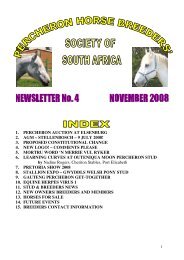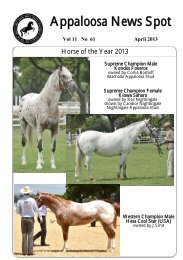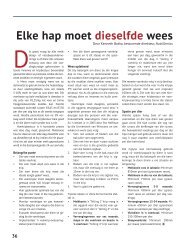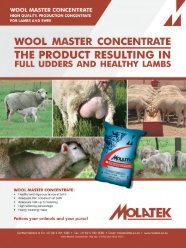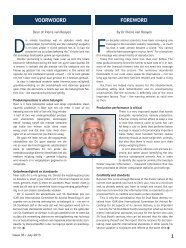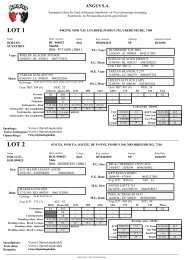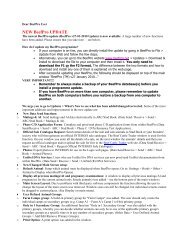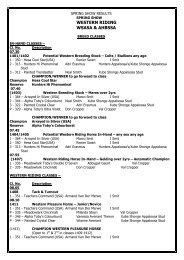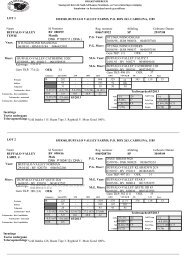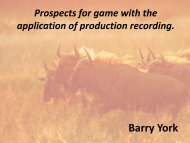Ekonomiese impak van genetiese verbetering op die ... - Stamboek
Ekonomiese impak van genetiese verbetering op die ... - Stamboek
Ekonomiese impak van genetiese verbetering op die ... - Stamboek
You also want an ePaper? Increase the reach of your titles
YUMPU automatically turns print PDFs into web optimized ePapers that Google loves.
<strong>Ekonomiese</strong> <strong>impak</strong> <strong>van</strong> <strong>genetiese</strong> <strong>verbetering</strong><br />
<strong>op</strong> <strong>die</strong> veebedryf<br />
<strong>Stamboek</strong> Teeltsimposium<br />
1 Mei 2013<br />
Bloemfontein<br />
Free State
Why we are in the business – or is it that<br />
simple??<br />
Red meat consumption is embedded in the South African culture…<br />
Biltong<br />
Pap en vleis<br />
Indian lamb curry<br />
Braaivleis
Menu<br />
• Realities we must account for<br />
• Evolving meat industry<br />
• The value chain<br />
• Genetics and its benefits
Billions<br />
1950<br />
1956<br />
1962<br />
1968<br />
1974<br />
1980<br />
1986<br />
1992<br />
1998<br />
2004<br />
2010<br />
2016<br />
2022<br />
2028<br />
2034<br />
2040<br />
2046<br />
Realities the global and local meat industry<br />
faces<br />
• P<strong>op</strong>ulation, income growth and the<br />
changing consumer base<br />
10<br />
8<br />
6<br />
4<br />
2<br />
4 %<br />
2 %<br />
0 %<br />
5 % 9 %<br />
34 %<br />
30 %<br />
9 %<br />
0<br />
6 %<br />
1 %<br />
World P<strong>op</strong>ulation<br />
U.S Census Bureau (International Data Base), 2010<br />
7
Change in the composition of <strong>die</strong>ts and nutritional<br />
value and availability<br />
Source: http://www.grida.no/publications/rr/foodcrisis/page/3559.aspx<br />
The demand for grain for use in<br />
intensive livestock production can<br />
increase to more than 50% of total<br />
grain production (Keyzer et al., 2005).
Scale of Importnace<br />
We are not servicing a homogeneous consumer<br />
group (Free State Consumer Survey)<br />
6.0<br />
5.0<br />
4.0<br />
3.0<br />
2.0<br />
1.0<br />
0.0<br />
Price<br />
Quality<br />
Convenience<br />
Health Cons<br />
Food Safety<br />
Traceability<br />
Attributes<br />
Cook time<br />
Packaging<br />
Brand<br />
Tatste<br />
Nut Info<br />
Inferior Conumer (low nutrition) (34.8%) n = 282 At Home (Basics) (23.7%) n = 192<br />
Balanced Consumer (26.6%) n = 216 Value Added Orientated (12.3%) n = 100<br />
High Frequency Consumer (Broad Product Range) (2.6%) n = 21<br />
Source: Botha, F., Taljaard, P., Jooste, A. & Pelser, A. (2007). UFS.<br />
9
Per capita consumption (Kg)<br />
The effect of the recession on meat<br />
consumption<br />
35<br />
30<br />
25<br />
Meat, Beef and Veal<br />
Poultry, Meat, Broiler<br />
Before recession<br />
Strong<br />
increase<br />
During recession<br />
Slight<br />
increase<br />
After recession<br />
Increase<br />
20<br />
15<br />
Increase<br />
Decrease<br />
Constant<br />
10<br />
2000 2001 2002 2003 2004 2005 2006 2007 2008 2009 2010 2011<br />
Source: USDA, 2011
Realities the global and local meat industry<br />
faces<br />
• Changing economic power position in the<br />
global economy<br />
• China, Brazil, India, Africa<br />
130 000<br />
120 000<br />
110 000<br />
100 000<br />
90 000<br />
80 000<br />
70 000<br />
60 000<br />
50 000<br />
International outlook for meat<br />
consumption<br />
Poultry<br />
Pork<br />
Beef<br />
110 000<br />
100 000<br />
40 000<br />
2000 2002 2004 2006 2008 2010 2012 2014 2016 2018 2020<br />
2000 2002 2004 2006 2008 2010 2012 2014 2016 2018 2020<br />
Source: http://www.fao.org/economic/est/commodity-markets-monitoring-and-outlook/meat/en/, 2011; taken from US Meat Export<br />
11<br />
Federation<br />
90 000<br />
80 000<br />
70 000<br />
60 000<br />
50 000<br />
40 000<br />
International outlook for meat<br />
consumption – Excluding China<br />
Poultry<br />
Pork<br />
Beef
Realities the global and local meat industry<br />
• Climate change<br />
• Resource availability<br />
faces<br />
• Arable land capable of sustaining intensive to<br />
moderately well adapted cultivation amounts to<br />
about 12.6 % of South Africa’s land<br />
– Of this, only 2 % (2 446 million hectares) is<br />
prime agricultural land<br />
– A further 11% can be added<br />
12
AT-25C<br />
AT-30<br />
DE-1100<br />
DE-1400<br />
FR-70C<br />
FR-80<br />
FR-85<br />
ES-90<br />
ES-180<br />
IE-25<br />
UK-40<br />
UK-105<br />
SE-60<br />
SE-80<br />
NO-45<br />
HU-150T<br />
HU-880T<br />
CZ-350<br />
UA-410<br />
CA-170<br />
US-240<br />
US-500<br />
AR-700<br />
AR-1000<br />
AR-730<br />
AR-800<br />
BR-400<br />
BR-1070<br />
CO-240<br />
MX-120<br />
CN-2<br />
ID-2<br />
ID-4<br />
ID-3<br />
ID-30<br />
AU-500<br />
AU-540C<br />
AU-700<br />
AU-1100<br />
ZA-200<br />
ZA-250<br />
ZA-400<br />
calves per 100 cows & year<br />
120<br />
International competitiveness: Calving<br />
percentages<br />
100<br />
80<br />
60<br />
40<br />
20<br />
0<br />
Source: Agribenchmark, 2009
Feb-08<br />
Apr-08<br />
Jun-08<br />
Aug-08<br />
Oct-08<br />
Dec-08<br />
Feb-09<br />
Apr-09<br />
Jun-09<br />
Aug-09<br />
Oct-09<br />
Dec-09<br />
Feb-10<br />
Apr-10<br />
Jun-10<br />
Aug-10<br />
Oct-10<br />
Dec-10<br />
Feb-11<br />
Apr-11<br />
Jun-11<br />
Aug-11<br />
Oct-11<br />
Dec-11<br />
Feb-12<br />
Apr-12<br />
Jun-12<br />
Aug-12<br />
Oct-12<br />
Dec-12<br />
Index Jan 2008 = 100<br />
Realities the global and local meat industry<br />
faces<br />
• Changing cost relations (sustainability)<br />
150<br />
140<br />
130<br />
120<br />
110<br />
100<br />
90<br />
80<br />
70<br />
60<br />
Primary agriculture inflation<br />
Food manufacturing inflation<br />
Food and non-alcoholic beverage inflation<br />
Source: Stat SA, 2013<br />
14
AT-25C<br />
AT-30<br />
DE-1100<br />
DE-1400<br />
FR-70C<br />
FR-80<br />
FR-85<br />
ES-90<br />
ES-180<br />
IE-25<br />
UK-40<br />
UK-105<br />
SE-60<br />
SE-80<br />
NO-45<br />
HU-150T<br />
HU-880T<br />
CZ-350<br />
UA-410<br />
CA-170<br />
US-240<br />
US-500<br />
AR-700<br />
AR-1000<br />
AR-730<br />
AR-800<br />
BR-400<br />
BR-1070<br />
CO-240<br />
MX-120<br />
CN-2<br />
ID-2<br />
ID-4<br />
ID-3<br />
ID-30<br />
AU-500<br />
AU-540C<br />
AU-700<br />
AU-1100<br />
ZA-200<br />
ZA-250<br />
ZA-400<br />
International competitiveness: Income<br />
US$ per 100 kg live weight<br />
700<br />
600<br />
500<br />
Government payments<br />
Weaner and transfer to beef receipts<br />
Breeding livestock receipts<br />
Cull animals and slaughter receipts<br />
400<br />
300<br />
200<br />
100<br />
0<br />
Source: Agribenchmark , 2009
BR-1070<br />
AU-1900<br />
AU-700<br />
BR-400<br />
AR-730<br />
AR-1300<br />
AU-500<br />
UK-40<br />
AU-540<br />
CO-240<br />
ZA-250<br />
US-500<br />
ZA-200<br />
ZA-300<br />
US-240<br />
FR-70C<br />
CN-2<br />
FR-80<br />
ID-SU-1C<br />
HU-150T<br />
FR-85<br />
DE-1100<br />
CA-170<br />
DE-1400<br />
ES-160<br />
ES-90<br />
HU-880T<br />
AT-30<br />
UK-100<br />
IE-25<br />
SE-80<br />
ID-SU-2C<br />
NO-45<br />
AT-25C<br />
SE-60<br />
International competitiveness: Costs<br />
800<br />
US$ per 100 kg live weight<br />
700<br />
600<br />
500<br />
400<br />
300<br />
200<br />
100<br />
0<br />
Source: Agribenchmark , 2008
Feb-08<br />
Apr-08<br />
Jun-08<br />
Aug-08<br />
Oct-08<br />
Dec-08<br />
Feb-09<br />
Apr-09<br />
Jun-09<br />
Aug-09<br />
Oct-09<br />
Dec-09<br />
Feb-10<br />
Apr-10<br />
Jun-10<br />
Aug-10<br />
Oct-10<br />
Dec-10<br />
Feb-11<br />
Apr-11<br />
Jun-11<br />
Aug-11<br />
Oct-11<br />
Dec-11<br />
Feb-12<br />
Apr-12<br />
Jun-12<br />
Aug-12<br />
Oct-12<br />
Dec-12<br />
Feb-08<br />
Apr-08<br />
Jun-08<br />
Aug-08<br />
Oct-08<br />
Dec-08<br />
Feb-09<br />
Apr-09<br />
Jun-09<br />
Aug-09<br />
Oct-09<br />
Dec-09<br />
Feb-10<br />
Apr-10<br />
Jun-10<br />
Aug-10<br />
Oct-10<br />
Dec-10<br />
Feb-11<br />
Apr-11<br />
Jun-11<br />
Aug-11<br />
Oct-11<br />
Dec-11<br />
Feb-12<br />
Apr-12<br />
Jun-12<br />
Aug-12<br />
Oct-12<br />
Dec-12<br />
Index 2008 = 100<br />
Index 2008 = 100<br />
Regulated prices and increasing food prices<br />
240<br />
145<br />
220<br />
200<br />
180<br />
Water and other services<br />
Electricity and other fuels<br />
135<br />
125<br />
Processed<br />
Unprocessed<br />
160<br />
140<br />
115<br />
120<br />
105<br />
100<br />
80<br />
95<br />
60<br />
85<br />
Price increase from February 2008 to December 2012<br />
Water and other services – 49 % Processed food products – 46.7 %<br />
Electricity and other fuels – 147.7 %<br />
Unprocessed food products – 36.5 %<br />
Stat SA, 2013<br />
17
Dec-07<br />
Feb-08<br />
Apr-08<br />
Jun-08<br />
Aug-08<br />
Oct-08<br />
Dec-08<br />
Feb-09<br />
Apr-09<br />
Jun-09<br />
Aug-09<br />
Oct-09<br />
Dec-09<br />
Feb-10<br />
Apr-10<br />
Jun-10<br />
Aug-10<br />
Oct-10<br />
Dec-10<br />
Feb-11<br />
Apr-11<br />
Jun-11<br />
Aug-11<br />
Oct-11<br />
Dec-11<br />
Feb-12<br />
Apr-12<br />
Jun-12<br />
Aug-12<br />
Oct-12<br />
Dec-12<br />
Feb-13<br />
Crude oil (US$/barrel)<br />
Fuel price (R/litre)<br />
Fuel prices<br />
160<br />
140<br />
120<br />
100<br />
80<br />
60<br />
Crude oil<br />
Petrol 95 ULP Gauteng<br />
Diesel 0.05% S Gauteng<br />
13<br />
12<br />
11<br />
10<br />
9<br />
8<br />
Feb 2013 – Diesel price =<br />
R11.29/l<br />
18 cent increase from<br />
January 2013 translate to<br />
an additional R1.78 million<br />
expenditure for farmers on<br />
an annual base!!<br />
40<br />
20<br />
7<br />
6<br />
Mar 2013 – Diesel price =<br />
R11.88/l<br />
0<br />
18<br />
5<br />
58 cent increase from<br />
February 2013 translate to<br />
an increase of R5.84 million<br />
in expenditure for farmers<br />
on an annual base!!
2004<br />
2005<br />
2006<br />
2007<br />
2008<br />
2009<br />
2010<br />
2011<br />
2012<br />
Transport costs<br />
1.1.<br />
1.2.3.<br />
1.2.2.2.<br />
Rand<br />
1400000<br />
1200000<br />
1000000<br />
Rand<br />
4500000<br />
4000000<br />
3500000<br />
3000000<br />
Rand<br />
4500000<br />
4000000<br />
3500000<br />
3000000<br />
800000<br />
2500000<br />
2500000<br />
600000<br />
400000<br />
200000<br />
0<br />
Capital Cost Fixed Cost Running Cost<br />
2004 2006 2008 2010 2012<br />
2000000<br />
1500000<br />
1000000<br />
500000<br />
0<br />
Capital Cost Fixed Cost<br />
Running Cost<br />
2004 2006 2008 2010 2012<br />
2000000<br />
1500000<br />
1000000<br />
500000<br />
0<br />
Capital Cost Fixed Cost Running Cost<br />
2-axle vehicles: 6-axle vehicles: 7-axle vehicles:<br />
Capital cost: 18.4 %<br />
Fixed cost: 37.8 %<br />
Running cost: 126.4 %<br />
Source: Max Braun Consulting Services, 2013.<br />
Capital cost: 38.3 %<br />
Fixed cost: 53.3 %<br />
Running cost: 133 %<br />
Capital cost: 40.4 %<br />
Fixed cost: 57.5 %<br />
Running cost: 174.6 %<br />
19
Percentage of total costs<br />
Costs at retail level<br />
100<br />
90<br />
1.45 0.61<br />
3.63<br />
1.63<br />
80<br />
70<br />
60<br />
50<br />
40<br />
30<br />
20<br />
10<br />
0<br />
51.46<br />
9.69<br />
2.78<br />
12.04<br />
16.71<br />
Retailer costs<br />
Other<br />
Other consumables<br />
Animal Transportation<br />
Certification costs<br />
Land costs (rental)<br />
Packaging costs<br />
Water and other utilities<br />
Electricity<br />
Labour costs<br />
Bron: NAMC (2010)<br />
Nota: Examples of other consumables are knives, blades, sharpeners etc.<br />
20
New things on the radar…<br />
Health concerns<br />
Environmental<br />
concerns<br />
Animal care<br />
Source: USDA, 2011
Evolving meat industry
2000/01<br />
2001/02<br />
2002/03<br />
2003/04<br />
2004/05<br />
2005/06<br />
2006/07<br />
2007/08<br />
2008/09<br />
2009/10<br />
2010/11<br />
Percentage<br />
Position of the red meat industry in South Africa<br />
% contribution to gross value of agricultural production<br />
60<br />
50<br />
40<br />
30<br />
20<br />
10<br />
0<br />
ANIMAL PRODUCTS HORTICULTURE FIELD CROPS<br />
Source: DAFF, 2011<br />
23
2000/01<br />
2001/02<br />
2002/03<br />
2003/04<br />
2004/05<br />
2005/06<br />
2006/07<br />
2007/08<br />
2008/09<br />
2009/10<br />
2010/11<br />
Rand (thousand)<br />
Position of the red meat industry in South Africa<br />
30 000 000<br />
25 000 000<br />
20 000 000<br />
15 000 000<br />
10 000 000<br />
5 000 000<br />
Gross value of selected livestock products<br />
Catlle and calves Sheep and goats Pigs Milk Broilers<br />
Source: DAFF, 2011<br />
24
Per capita consumption (Kg)<br />
Meat consumption, beef consumption vs<br />
poultry consumption<br />
35<br />
30<br />
25<br />
20<br />
2000 – 2011:<br />
Per capita consumption of poultry<br />
51 %,<br />
per annum,<br />
3.5%<br />
2000 – 2011:<br />
Per capita consumption of beef<br />
1.05 %,<br />
per annum,<br />
0.1%<br />
15<br />
10<br />
2000 2001 2002 2003 2004 2005 2006 2007 2008 2009 2010 2011<br />
Meat, Beef and Veal<br />
Poultry, Meat, Broiler<br />
Source: Own calculation based on different sources
Transition of the industry (example of beef)<br />
1970s 1980s 1990s 2000s<br />
OPPORTUNITY<br />
DRIVEN<br />
PRODUCTION<br />
DRIVEN<br />
COST DRIVEN<br />
CONSUMER<br />
DRIVEN<br />
- Low and inconsistent<br />
quality meat.<br />
-Grain farmers market<br />
grains alternatively<br />
and started feeding<br />
younger animals.<br />
-Trade in cattle<br />
controlled by<br />
auctioneers.<br />
Source: Ford<br />
-Movement towards<br />
more intensive feeding<br />
of cattle.<br />
-Industry expanded<br />
dramatically.<br />
-Stakeholders start<br />
taking cognizance of<br />
consumer needs.<br />
-Industry controlled by<br />
three large companies.<br />
-Industry experience<br />
effects of deregulation<br />
and liberalization.<br />
-New environment<br />
increased risk and<br />
lowered prices.<br />
-Three big companies<br />
disinvested.<br />
-Industry re-orientated<br />
to produce more costefficiently.<br />
-Movement towards<br />
direct buying and selling<br />
of animals.<br />
Question is whether the industry has<br />
become sufficiently value driven??<br />
-Industry realized the<br />
importance of the<br />
consumer.<br />
-Greater emphasis in<br />
providing consistent<br />
quality, adding value,<br />
the devel<strong>op</strong>ment of<br />
standards and<br />
increased<br />
involvement in chain.<br />
-Feedlot industry<br />
stimulated by<br />
achieving better<br />
economies of scale.
The value chain is the key!!
Source Roduner (2005)<br />
28
Example of a value chain<br />
Consumers<br />
Input suppliers<br />
Retailers<br />
Producers<br />
Marketing<br />
Segments<br />
Processors<br />
Traders<br />
Production<br />
Segments<br />
Abattoir<br />
Feedlots<br />
Product flow<br />
Financial flow<br />
Information flow<br />
Source: Adapted from Schroeder, 2003
Dualistic value chains: Formal market<br />
30
Dualistic value chains: Informal market<br />
Source: Van Rooyen et al.<br />
32
And somewhere we have to strike a balance<br />
??!!??<br />
Source: Photo at Groblersho<strong>op</strong> abattoir
Where does genetic<br />
improvement fit in??
There has been progress, but also some<br />
uncertainties<br />
• Management<br />
• Environment<br />
• Externalities
Why genetic improvement? - Consumer<br />
– Looking for value for money<br />
• Willingness to pay<br />
– Quality (e.g. tenderness)<br />
– Changing consumer behaviour<br />
• Buying cuts vs buying portions<br />
• Positioning according to LSM groups<br />
– Major question – does genetic improvement do<br />
something for the poor consumer
Why genetic improvement? – Retailers<br />
• Establishing brands<br />
– Brand attributes, e.g.<br />
• Optimal growth without growth stimulants<br />
• Free range, i.e. adaptability, reproduction<br />
• Procurement<br />
– Early 2000’s: 80% carcass, 20 % in primary cuts, no value<br />
added products.<br />
– Currently: 50% carcass, 30 % in primary cuts, 20 % valueadded<br />
products.<br />
• Focus on productivity and sustainability<br />
• Preference for certain breeds
Why genetic improvement? – Feedlots,<br />
Processing<br />
• Feed conversion ratio (Avg daily gains vs cost<br />
of feed)<br />
• Yield per carcass<br />
– Focus on <strong>op</strong>timal carcasses
Why genetic improvement? - Producer<br />
• Enhanced growth attributes<br />
– Feed conversion<br />
– Pre and post weaner growth<br />
• Enhanced reproduction<br />
– Number of calves per cow<br />
– Survival attributes<br />
– Milk production<br />
– Longlivity
What does the evidence suggest?<br />
• Earlier South African evidence<br />
– Rate-of-return estimates (1994-92):<br />
• General (1994-92): 5% (???)<br />
• Animal Health (1947 -82) : >36%<br />
• Animal production (1947 – 94): 11-16%<br />
• Dairy, beef, mutton, and pig performance and progeny<br />
testing schemes (1970 – 96):<br />
– National Dairy Cattle Performance and Progeny Testing Scheme<br />
51%,<br />
– National Beef Cattle Performance and Progeny Testing Scheme<br />
44%,<br />
– National Mutton Sheep Performance and Progeny Testing<br />
Scheme 54%<br />
– National Pig Performance and Progeny Testing Scheme 14%.<br />
Cited from Mokoena (1998) & Liebenberg, F (2012)
Case study:<br />
Economic Value of Improvements in Beef<br />
Tenderness by Genetic Marker Selection<br />
Weaber, R.L. and Lusk, J.L. (2010) – Amer. Jour. of Agric. Econ.<br />
• Over time much research focusses on postharvest<br />
interventions<br />
– Aging<br />
– Electrical stimulation, etc<br />
• However,<br />
– Techniques as costly<br />
– Consumer acceptance issues<br />
• Research focus on pre-harvest strategies to<br />
improve tenderness<br />
– 12% to 43% of variation in steak tenderness is under<br />
genetic control (Minick et al, 2004; Koots et al, 2004)
Case study:<br />
Economic Value of Improvements in Beef<br />
Tenderness by Genetic Marker Selection<br />
• Methodology involve, amongst others,<br />
– The Warner-Bratzler shear force (WBSF) method<br />
• Correlation between variations in animals DNA and<br />
WBSF at slaughter (Casas et al, 2006; Schenkel et al, 2006)<br />
– Genetic simulation model<br />
• Mean WBSF values projected over a 20-year period as a<br />
result of six different strategies<br />
Weaber, R.L. and Lusk, J.L. (2010)
Case study:<br />
Economic Value of Improvements in Beef<br />
Tenderness by Genetic Marker Selection<br />
• Methodology involve, amongst others,<br />
– Different strategies, for example<br />
• Non Aggressive selection strategy (50% of good<br />
performing bulls)<br />
• Mild aggressive strategy (30% of good performing bulls)<br />
• Aggressive strategy (10% of good performing bulls)<br />
Weaber, R.L. and Lusk, J.L. (2010)
Case study:<br />
Economic Value of Improvements in Beef<br />
Tenderness by Genetic Marker Selection<br />
• Different strategies: RESULTS<br />
Item 50% 30% 10%<br />
Year 1 4.61 4.61 4.61<br />
Year 20 4.50 4.45 4.37<br />
Reduction in mean WBSF (kg) 0.11 0.16 0.24<br />
Reduction in mean WBSF (%) 2.5% 3.6% 5.4%<br />
Monetary value (billion) $5255 Benefits $7603 can $11332 be<br />
added through<br />
post slaughter<br />
interventions –<br />
not permanent<br />
• Benefits distributed throughout the chain:<br />
– 31% to consumers<br />
– 10% to retail<br />
– 3% to packers<br />
– 7% to feedlots<br />
– 49% to producers<br />
Weaber, R.L. and Lusk, J.L. (2010)
Performance changes in poultry and livestock<br />
following 50 years of genetic selection<br />
• Several sources of data used to illustrate:<br />
– Changes in efficiency have:<br />
• reduced the amount of feedstuffs<br />
required to produce a unit of product<br />
• the amount of waste produced,<br />
compared to the inefficiencies in the<br />
1950s.<br />
Havenstein, G.B (2006)
Performance changes in poultry and livestock<br />
following 50 years of genetic selection<br />
- 85-90 percent of the change in growth rate has been due to genetic selection,<br />
- only 10-15 percent of the change is due to improvements in nutrition and<br />
nutritional management.<br />
Havenstein, G.B (2006)
Performance changes in poultry and livestock<br />
following 50 years of genetic selection<br />
Cattle inventory and beef production<br />
Havenstein, G.B (2006)
Concluding remarks<br />
• Partnering<br />
“You must earn with your partner, and not<br />
from your partner”<br />
- Ashish Thakkar (CEO KARA Group)<br />
• Productivity Gap versus the Opportunity<br />
Gap<br />
“If you don’t lead change, you will become a<br />
victim of change”<br />
– Henry Ford
Thank you<br />
Contact details:<br />
Dr A Jooste<br />
Tel: +27 (0) 83 307 3703<br />
E-mail: andrej@potatoes.co.za<br />
Acknowledgments:<br />
Prof Esti Koster<br />
Heiko Koster<br />
Helena Theron<br />
Gerhard Schutte<br />
Frikkie Liebenberg
“Well-fed pe<strong>op</strong>le have many<br />
problems, hungry pe<strong>op</strong>le only have<br />
one”<br />
Traditional Chinese proverb



